
Melaleuca radula, commonly known as graceful honey-myrtle, is a plant in the myrtle family, Myrtaceae and is endemic to the south-west of Western Australia. It is an open, spreading shrub with narrow leaves, profuse pink or purple flowers in late winter and smooth, almost spherical fruits.
Melaleuca boeophylla is a plant in the myrtle family, Myrtaceae and is endemic to the south-west of Western Australia. It is similar to a number of other Western Australian melaleucas such as M. filifolia with its purple pom-pom flower heads but its leaves are shorter and oval in cross-section.
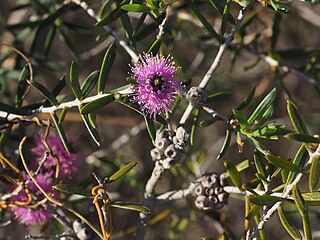
Melaleuca caeca is a plant in the myrtle family, Myrtaceae and is endemic to the south-west of Western Australia. It is similar to a number of other Western Australian melaleucas such as M. pentagona with its purple pom-pom flower heads but it is a smaller shrub with narrower leaves and smaller inflorescences.

Melaleuca campanae is a plant in the myrtle family, Myrtaceae and is endemic to the south-west of Western Australia. It is a small, woody shrub similar to Melaleuca eulobata, with a low, spreading habit and pinkish flower heads but it has longer, pointed leaves and lacks distinct sepals which instead form a ring of tissue around the edge of the flowers.
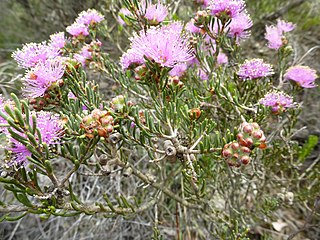
Melaleuca carrii is a plant in the myrtle family, Myrtaceae and is endemic to the south-west of Western Australia. It is a small shrub similar to Melaleuca pentagona, with "pom-pom" heads of pinkish flowers and sharply pointed leaves but it is generally smaller, lacks a groove in its leaves and retains its petals on the flowers for longer than that species.

Melaleuca longistaminea is a plant in the myrtle family Myrtaceae, and is endemic to the south-west of Western Australia. It is a shrub with small, prickly, heart-shaped leaves and heads of yellow to green flowers on the sides of the stems in winter and spring. It is similar to Melaleuca spectabilis which was formerly included in this species but has smaller flowerheads and narrower leaves.

Melaleuca nematophylla, commonly known as wiry honey-myrtle is a plant in the myrtle family, Myrtaceae and is endemic to the south-west of Western Australia. It is one of the showiest melaleucas when in flower in early spring, is easily grown and has unusual needle-like foliage. As a result, it is relatively common in cultivation in temperate parts of Australia.
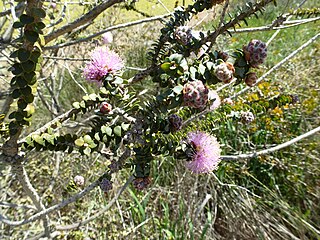
Melaleuca orbicularis is a plant in the myrtle family, Myrtaceae and is endemic to the south-west of Western Australia. It is similar to Melaleuca cordata with its pinkish "pom-pom" heads of flowers but its leaves are smaller, almost circular compared to the heart shaped leaves of the other species.

Melaleuca ryeae is a plant in the myrtle family, Myrtaceae and is endemic to the south west of Western Australia. It is a small shrub, closely resembling Melaleuca amydra with its small leaves and profuse heads of pink to purple flowers but M.amydra has narrower leaves and does not have spherical clusters of fruits.
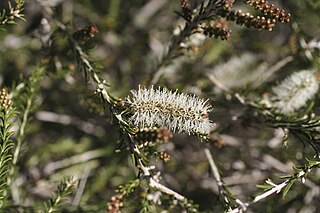
Melaleuca adnata, commonly known as sandhill honey-myrtle, is a plant in the myrtle family, Myrtaceae and is endemic to the south-west of Western Australia. It is a tall shrub with papery bark and spikes of white flowers in spring and early summer.

Melaleuca leiocarpa, commonly known as pungent honey-myrtle, is a plant in the myrtle family, Myrtaceae and is native to arid areas in parts of South Australia and Western Australia. It is an erect or branching shrub distinguished by its prickly foliage, yellowish flowers and, for a melaleuca, unusually large, smooth, roughly spherical fruits.

Melaleuca ciliosa is a small shrub in the myrtle family, Myrtaceae and is endemic to the south-west of Western Australia. It has bright or pale yellow flowers, an unusual calyx and leaves that are slightly hairy, especially around the edges.

Melaleuca conothamnoides is a shrub in the myrtle family, Myrtaceae and is endemic to the south-west of Western Australia. It is distinguished by its relatively large leaves, prominent oil glands and unusual bracts covering the flower buds before they open.

Melaleuca filifolia, commonly called wiry honey-myrtle, is a plant in the myrtle family Myrtaceae, and is endemic to the south-west of Western Australia. It is a woody, twiggy shrub with needle-shaped leaves, greenish flower buds, pink "pom-pom" flower heads and spherical clusters of fruits.
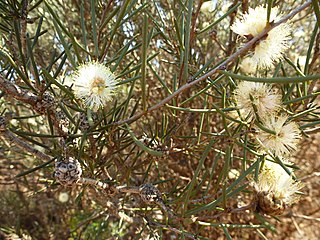
Melaleuca hamata is a plant in the myrtle family, Myrtaceae and is endemic to the south-west of Western Australia. It grows to a large, dense shrub with broombrush foliage and profuse pale yellow flowers in late spring.
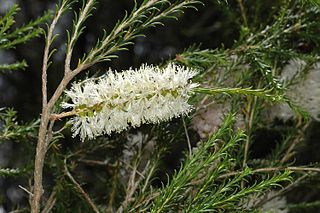
Melaleuca hamulosa is a plant in the myrtle family, Myrtaceae and is endemic to the south-west of Western Australia. It is a broom-like shrub with many stiff, ascending branches and spikes of white or pale mauve flowers in spring or summer.

Melaleuca psammophila is a plant in the myrtle family, Myrtaceae, and is endemic to the south-west of Western Australia. It is a small shrub with narrow leaves, heads of purple, pink or mauve flowers and clusters of woody fruit. It is similar to M. bisulcata but differs from that species in characters such as the shape of its fruit, leaves and buds but like that species is an attractive, profusely flowering shrub suitable for cultivation as a garden plant.
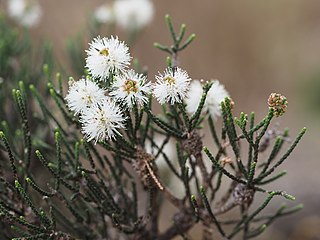
Melaleuca thyoides, commonly known as salt lake honey-myrtle is a plant in the myrtle family, Myrtaceae and is endemic to the south-west of Western Australia. It is an erect shrub with grey, papery or fibrous bark and very small, overlapping leaves on thin branchlets. It is a salt tolerant species often found on the edges of salt lakes.

Calothamnus brevifolius is a plant in the myrtle family, Myrtaceae and is endemic to the south-west of Western Australia. It is a small, highly branched shrub with almost cylindrical, pointed leaves and red flowers in summer. In 2014 Craven, Edwards and Cowley proposed that the species be renamed Melaleuca hawkeswoodii.
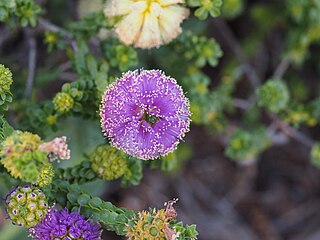
Phymatocarpus porphyrocephalus is a plant in the myrtle family, Myrtaceae and is endemic to the south-west of Western Australia. It resembles many small species of Melaleuca, mainly differing in the way its anthers are attached at the top of the stamens. In Phymatocarpus they are attached at their base and open at the other end through two slits. It is a shrub with many small heads of pink to purple flowers fading to white, often covering the plant for several weeks in spring.





















